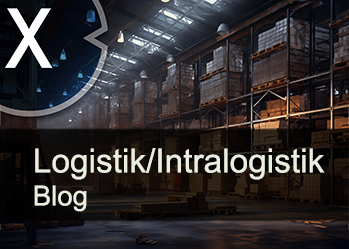The transformation of an entire infrastructure: high-bay containers, micro-hubs, blockchain, automation and robotics
Xpert pre-release
Language selection 📢
Published on: September 8, 2025 / Updated on: September 8, 2025 – Author: Konrad Wolfenstein

The transformation of an entire infrastructure: containers from the high-bay rack, micro-hubs, blockchain, automation and robotics – Image: Xpert.Digital
The future of global logistics: Transforming an entire infrastructure over the next ten years
More than just trucks: Why logistics is facing its biggest upheaval since the invention of the container
The logistics industry is at the beginning of a fundamental transformation that will fundamentally change the way goods are produced, transported, and stored over the next ten years. This revolution encompasses all areas of the supply chain – from procurement and production to final delivery to the end customer. The drivers of this development are diverse: technological breakthroughs, changing customer expectations, sustainability requirements, and the need for more resilient supply chains.
Suitable for:
- The backbone of world trade: An in-depth analysis of global container logistics and the port warehousing revolution
Digitalization and automation as the foundation of new logistics
Digitalization forms the backbone of the future logistics world. Artificial intelligence, big data, and the Internet of Things are increasingly becoming indispensable tools for optimizing processes, reducing costs, and promoting sustainability. These technologies enable companies to make their operations more efficient while responding more flexibly to market changes.
Automated warehouses and robotics will increase efficiency and minimize error rates. Autonomous systems such as robots and drones have the potential to revolutionize warehouse logistics and delivery by 2035. Warehouses are expected to operate almost fully automated, leading to significant reductions in operating costs. Companies are already relying on warehouse management systems that monitor goods and their transport, while wearable RF scanners and even drones are being used for inventory tracking.
AI-driven route optimization improves the efficiency of delivery routes and saves time and fuel. At the same time, CO2 emissions are reduced, which is crucial given increasing sustainability requirements. Artificial intelligence and algorithms will organize and automate complex processes within and between companies more efficiently.
Autonomous vehicles and the redesign of transport
Autonomous vehicles are poised to revolutionize the logistics industry. The use of autonomous trucks can help the logistics industry reduce the need for vehicles and skilled workers. This technology enables vehicles to operate around the clock, significantly reducing delivery times.
Autonomous trucks are already being tested, particularly on highways. The ATLAS-L4 research and development project has been demonstrating since 2022 that the use of Level 4 automated, and thus driverless, vehicles on highways is feasible. Integrating autonomous systems into logistics processes can reduce costs by optimizing fuel consumption and reducing vehicle wear and tear.
Platooning technology allows trucks to drive closely behind each other and communicate with each other to optimize traffic flow. If the first truck brakes, the following vehicles can automatically brake and accelerate with the same force in the same second. This reduces the risk of traffic jams, improves traffic flow, and keeps fuel consumption low.
Container high-bay warehouse: The future of port logistics
A particularly innovative development is container high-bay warehouses, which have the potential to fundamentally transform port logistics. These systems make it possible to store standard sea containers in huge, fully automated racking systems instead of stacking them flat and only a few layers high.
Unlike traditional container yards, where containers are stacked on top of each other using cranes or straddle carriers, a high-bay warehouse assigns each individual container a fixed, individual shelf compartment. Containers are transported to and from these compartments fully automatically by rail-guided storage and retrieval machines or other specialized robotic systems.
The world's first container high-bay warehouse has already been successfully tested. The Boxbay system, designed by the German plant manufacturer SMS Group, has successfully completed practical testing at the Port of Dubai. The facility offers more than three times the storage capacity in the same space compared to conventional solutions. The system consists of an automated high-bay warehouse with 11 storage levels and flexible interfaces for seaborne and landborne loading.
Suitable for:
- Container storage logistics in transition: Fundamental change through automation and high-bay technology
Sustainable logistics and decarbonization
Sustainability is becoming a key driver of logistics development. Companies are seeking innovative ways to reduce their carbon footprint, leading to increased use of alternative fuels and low-carbon packaging solutions.
Hydrogen technology is gaining traction as an alternative to diesel engines. Hydrogen vehicles can cover greater distances than electric vehicles, are non-polluting, and can be easily refueled in just a few minutes. Companies such as BAUHAUS and EDEKA Nord have already put the first hydrogen trucks into operation, achieving a range of up to 400 kilometers while producing only water vapor as emissions.
At the same time, electromobility is establishing itself as a key pillar of sustainable logistics. The development of battery-electric trucks is progressing, and these trucks are becoming cost-competitive and economically viable thanks to dedicated charging infrastructure at warehouses.
Artificial Intelligence in Supply Chain Management
Artificial intelligence is revolutionizing supply chain management through more accurate demand forecasting, improved inventory management, and optimized logistics. AI algorithms analyze massive data sets to create demand forecasts, enabling companies to adjust their production plans and reduce excess inventory.
Predictive analytics enables companies to predict future trends and potential bottlenecks, thereby minimizing risks and maximizing efficiency. Analyzing large amounts of data helps make informed decisions that optimize the entire supply chain. Predictive analytics is becoming increasingly important for supply chain management, making processes more accurate, reliable, and cost-effective.
Blockchain and IoT for transparency and traceability
The combination of blockchain and the Internet of Things opens up new possibilities for product monitoring and traceability in logistics. Blockchain technology increases transparency in supply chains, helps prevent counterfeiting, and enables real-time tracking of transport routes.
IoT devices offer unparalleled real-time visibility and data collection capabilities. They enhance real-time tracking and monitoring, which is essential for optimizing logistics and supply chain operations. IoT enables constant connectivity and real-time decision-making, as well as predictive maintenance.
Tracking systems use small sensors attached to materials or products to ensure accurate and up-to-date inventories at all times. These smart inventories can contain a wealth of information about the products themselves, their previous locations, and how long they have been present at a facility.
Your container high-bay warehouse and container terminal experts

Container high-bay warehouses and container terminals: The logistical interplay – Expert advice and solutions - Creative image: Xpert.Digital
This innovative technology promises to fundamentally change container logistics. Instead of stacking containers horizontally as before, they are stored vertically in multi-tiered steel rack structures. This not only enables a drastic increase in storage capacity within the same space but also revolutionizes the entire processes in the container terminal.
More about it here:
Circular economy: Logistics as a new revenue driver – Networked platforms and multimodality in freight transport
Resilience and risk management in supply chains
The pandemic and political uncertainty have demonstrated the vulnerability of global supply chains. By 2035, many companies will increasingly rely on reshoring, or relocating production sites closer to consumption centers, to minimize risks.
Resilient supply chains are defined by their ability to withstand and recover. They can mitigate disruptions in the supply chain or significantly limit their impact. The primary goal of supply chain risk management is to structure the supply chain so that it can successfully manage disruptions and integrate proactive measures to minimize risk.
Supply chain diversification will become a necessity. Companies will be forced to diversify their supply chains and build alternative production and transportation networks to minimize the risk of disruptions caused by geopolitical tensions or natural disasters.
Urban logistics and micro-hubs
Urban logistics faces major challenges due to increasing delivery traffic, which clogs streets and is often inefficiently managed. Microhubs offer a solution: small, strategically located distribution centers that are as close as possible to the end customer.
These intermediate stations act as an interface between large-volume goods deliveries and more complex end-customer deliveries. Instead of a delivery vehicle driving from a distant depot through the city's traffic, its route ends at the micro-hub. From there, smaller, often emission-free vehicles take over the last-mile delivery.
Micro-hubs primarily shorten the route to recipients and act as range extenders, expanding the use of cargo bikes and light electric vehicles for deliveries in urban areas. They allow the use of locally emission-free, environmentally friendly vehicles for resource-saving, urban-compatible, and efficient last-mile transport.
Suitable for:
- Urban supply logistics, micro-hubs, convenience stores and the digital solution with the GS1 DataMatrix Code
Drones in logistics
Drones are revolutionizing the last mile of delivery. The first commercial scheduled flight service using drones in Germany has already launched in North Rhine-Westphalia. As part of last-mile delivery, a transport drone will fly packages along a defined route to their destination and drop them off there.
It is particularly emphasized that not every drone needs to be controlled individually by a pilot. In a kind of control center, a trained employee can monitor ten to twelve drones simultaneously and intervene if any deviations occur. The drone can carry a payload of approximately 6.5 kilograms and has a flight time of up to 45 minutes.
The use of drones in logistics is being tested or already implemented in three main areas: surveillance and inspection, picking and inventory management, and last-mile delivery. Drones equipped with cameras and scanning technology can significantly reduce labor costs in the warehouse by scanning barcodes and transmitting them to the warehouse management system.
Additive manufacturing and 3D printing
3D printing promises to revolutionize the supply chain through decentralized production and on-demand manufacturing. This technology enables the production of products layer by layer from different materials and opens up new horizons in the supply chain through more agile and flexible methods.
3D printing makes the supply chain digital, decentralized, and flexible. Instead of transporting spare parts over long distances and storing them in large quantities, they can be manufactured locally – in exactly the quantities needed at the time. This reduces transport costs, shortens delivery times, and decreases capital tied up in inventory.
The advantages include increased flexibility in product design, faster prototyping, and the ability to realize complex geometries that would be impossible with conventional manufacturing methods. The potential is particularly evident in spare parts logistics: parts can be produced on demand without having to be stored for years.
Circular economy in logistics
The circular economy brings new opportunities to logistics and transforms or expands its business areas. Logistics is becoming the engine of the circular economy, which is not only about traditional delivery, but also about returns, recycling, and related services.
Reverse logistics refers to all processes in which goods continue their journey from their point of use within the supply chain. This can include returns management, conversion and exchange processes, repairs of goods, and the exchange of pallets and reusable containers. This onward logistics transforms linear supply chains into circular supply chains.
The circular economy is creating new markets, such as for spare parts or pay-per-use models, that can address new customer groups. Logistics companies can evolve from service providers to value-adding members of the supply chain. At the same time, new logistics-related business areas are emerging, such as the individual dismantling, processing, or repair of returned goods.
Networking and platform economy
The future of logistics lies in networked systems and platform solutions. Multimodal platforms enable interactive networking of all stakeholders across modes of transport and companies, as well as the data protection-compliant exchange of data, services, and experiences. These platforms offer the possibility of presenting logistics offerings across modes of transport and organizing optimized transport services based on various criteria.
Germany is developing a multimodal transport system for national and international freight transport. Depending on the goods, quantity, time required, and distance, transport can be handled using the most efficient transport routes. All stakeholders have access to comprehensive and up-to-date information regarding their freight transports.
Combined transport is gaining importance as an indispensable component. Long-distance transport is predominantly carried out by environmentally friendly freight trains and inland waterway vessels, which have continuously increased their share of the modal split.
Suitable for:
Agile supply chains: The key to tomorrow's competitive advantage
The transformation of global logistics over the next decade will not be without challenges. The introduction of new technologies will require significant investments in infrastructure, training, and the transformation of existing processes. At the same time, regulatory frameworks must be adapted to enable the use of autonomous vehicles, drones, and other innovative technologies.
The ability to adapt quickly to changing market conditions and customer needs will be crucial for logistics companies. Agile supply chains and flexibility will be key to meeting future challenges. Companies that can adapt their supply chains quickly will have a competitive edge.
The next ten years will show how these technological and strategic developments prove themselves in practice and what new innovations will emerge. What is certain, however, is that the logistics industry will undergo a fundamental transformation that will affect all areas, from production and transport to final delivery. High-bay containers will be just one visible symbol of this comprehensive change, which will enable a completely new way of globally exchanging goods.
Advice - planning - implementation
I would be happy to serve as your personal advisor.
Head of Business Development
Advice - planning - implementation
I would be happy to serve as your personal advisor.
contact me under Wolfenstein ∂ Xpert.digital
call me under +49 89 674 804 (Munich)



























